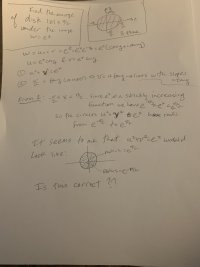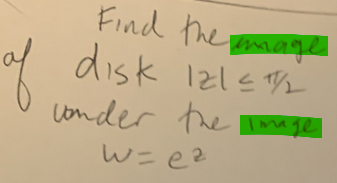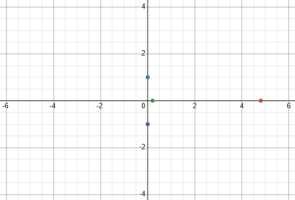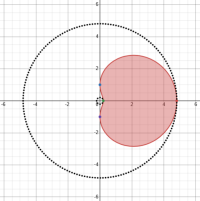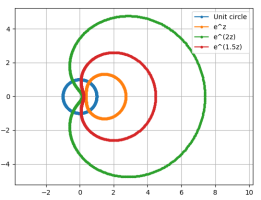You are using an out of date browser. It may not display this or other websites correctly.
You should upgrade or use an alternative browser.
You should upgrade or use an alternative browser.
Complex Analysis question
- Thread starter Steven G
- Start date
Dr.Peterson
Elite Member
- Joined
- Nov 12, 2017
- Messages
- 16,617
No, it's wrong. It may be true that the image will be a subset of your annulus (or one like it), but there's a lot you haven't taken into account.Can someone confirm if this correct? If not, what is/are my mistake(s)?
View attachment 38570
I would solve for x and y in terms of u and v, then set [imath]x^2+y^2\le\frac{\pi}{2}[/imath].
Also, there are some specific errors, such as neglecting to square [imath]e^x[/imath].
Professor Steven,
Mapping circuits (disks) under [imath]e^z[/imath] always produces annulus. Therefore, from the last diagram, I think that the idea of the answer is correct. I am just lazy to check the correct numerical solution!
Mapping circuits (disks) under [imath]e^z[/imath] always produces annulus. Therefore, from the last diagram, I think that the idea of the answer is correct. I am just lazy to check the correct numerical solution!
Last edited:
circlesProfessor Steven,
Mapping circuits (disks) under [imath]e^z[/imath] always produces annulus. Therefore, from the last diagram, I think that the idea of the answer is correct. I am just lazy to check the correct numerical solution!
Don't worry about it. It is just a typical engineers' mistake!
Dr.Peterson
Elite Member
- Joined
- Nov 12, 2017
- Messages
- 16,617
Really? I thought vertical lines mapped to circles, and horizontal lines to rays. So it would be vertical bars that would map to annuli, and that's really all @Steven G showed. (But since our disk is a subset of a vertical bar, its image will be a subset of that annulus.)Professor Steven,
Mapping [circles] (disks) under [imath]e^z[/imath] always produces annulus. Therefore, from the last diagram, I think that the idea of the answer is correct. I am just lazy to check the correct numerical solution!
I'd like to see the source of the problem; it seems harder than the answer is worth (being hard to graph by hand), but then I haven't done complex analysis in a long time. Might it have actually asked for the pre-image? (In any case, it was copied incorrectly, with the word "image" twice:
Vertical and horizontal lines are mapped into circles and rays under [imath]\displaystyle w = \frac{1}{z}[/imath] while circles are mapped into annulus under [imath]w = e^z[/imath] with annulus radius equal to [imath]e^{-r} \leq |w| \leq e^r[/imath] where [imath]r[/imath] is the radius of the disk.Really? I thought vertical lines mapped to circles, and horizontal lines to rays. So it would be vertical bars that would map to annuli, and that's really all @Steven G showed. (But since our disk is a subset of a vertical bar, its image will be a subset of that annulus.)
I'd like to see the source of the problem; it seems harder than the answer is worth (being hard to graph by hand), but then I haven't done complex analysis in a long time. Might it have actually asked for the pre-image? (In any case, it was copied incorrectly, with the word "image" twice:
Dr.Peterson
Elite Member
- Joined
- Nov 12, 2017
- Messages
- 16,617
Let's check that claim, by mapping the four simplest points on the given circle:Vertical and horizontal lines are mapped into circles and rays under [imath]\displaystyle w = \frac{1}{z}[/imath] while circles are mapped into annulus under [imath]w = e^z[/imath] with annulus radius equal to [imath]e^{-r} \leq |w| \leq e^r[/imath] where [imath]r[/imath] is the radius of the disk.
[math]e^{\frac{\pi}{2}}\approx4.81\\e^{\frac{\pi}{2}i}=\cos\frac{\pi}{2}+i\sin\frac{\pi}{2}=i\\e^{-\frac{\pi}{2}}\approx0.208\\e^{-\frac{\pi}{2}i}=\cos\frac{\pi}{2}-i\sin\frac{\pi}{2}=-i[/math]
These don't lie on a circle:
Here is my graph of the image, showing those points on it, and also the annulus it lies within:
What mistake have I made? Am I misinterpreting the problem?
Last edited:
Professor Dave, I might be wrong as I did not practise mapping for two years. But here is my analysis. The rotation of the disk is [imath]0 \leq \theta \leq 2\pi[/imath], so we have [imath]\displaystyle z = \frac{\pi}{2}(\cos \theta + i\sin\theta)[/imath]. This can be divided into [imath]\displaystyle x = \frac{\pi}{2}\cos \theta[/imath] and [imath]\displaystyle y = \frac{\pi}{2}\sin \theta[/imath] which are the real and imaginary parts respectively. Now, [imath]w = e^z = e^{x + iy} = e^{x}e^{iy} = e^x(\cos y + i\sin y)[/imath]. The magnitude of [imath]|w| = e^x[/imath], so we are interested in the real part from [imath]\displaystyle z[/imath] which is [imath]\displaystyle x = \frac{\pi}{2}\cos \theta[/imath].Let's check that claim, by mapping the four simplest points on the given circle:
[math]e^{\frac{\pi}{2}}\approx4.81\\e^{\frac{\pi}{2}i}=\cos\frac{\pi}{2}+i\sin\frac{\pi}{2}=i\\e^{-\frac{\pi}{2}}\approx0.208\\e^{-\frac{\pi}{2}i}=\cos\frac{\pi}{2}-i\sin\frac{\pi}{2}=-i[/math]
These don't lie on a circle:
Here is my graph of the image, showing those points on it, and also the annulus it lies within:
What mistake have I made? Am I misinterpreting the problem?
The maximum of [imath]x[/imath] happens when [imath]\displaystyle x = \frac{\pi}{2}\cos 0 = \frac{\pi}{2}[/imath].
The minimum of [imath]x[/imath] happens when [imath]\displaystyle x = \frac{\pi}{2}\cos \pi = -\frac{\pi}{2}[/imath].
Then,
[imath]\displaystyle e^{-\frac{\pi}{2}} \leq |w| \leq e^{\frac{\pi}{2}}[/imath].
--------------------
I don't understand why you want to use [imath]\displaystyle w = e^{\frac{\pi}{2}i}[/imath] when [imath]\displaystyle w = e^{\frac{\pi}{2} + yi}[/imath].
Last edited:
blamocur
Elite Member
- Joined
- Oct 30, 2021
- Messages
- 3,100
Very beautiful.
Professor blamocur, where did I go wrong in my analysis?
blamocur
Elite Member
- Joined
- Oct 30, 2021
- Messages
- 3,100
Your last inequality shows that the resulting line fits inside an annulus (as mentioned by @Dr.Peterson earlier), but it does not make the line itself being equal to that annulus.Very beautiful.
Professor blamocur, where did I go wrong in my analysis?

Do you mean this? [imath]\displaystyle e^{-\frac{\pi}{2}} \leq |w| \leq e^{\frac{\pi}{2}}[/imath].Your last inequality shows that the resulting line fits inside an annulus (as mentioned by @Dr.Peterson earlier), but it does not make the line itself being equal to that annulus.
How to correct it?
Dr.Peterson
Elite Member
- Joined
- Nov 12, 2017
- Messages
- 16,617
Why are you only interested in the magnitude of w?Professor Dave, I might be wrong as I did not practise mapping for two years. But here is my analysis. The rotation of the disk is [imath]0 \leq \theta \leq 2\pi[/imath], so we have [imath]\displaystyle z = \frac{\pi}{2}(\cos \theta + i\sin\theta)[/imath]. This can be divided into [imath]\displaystyle x = \frac{\pi}{2}\cos \theta[/imath] and [imath]\displaystyle y = \frac{\pi}{2}\sin \theta[/imath] which are the real and imaginary parts respectively. Now, [imath]w = e^z = e^{x + iy} = e^{x}e^{iy} = e^x(\cos y + i\sin y)[/imath]. The magnitude of [imath]|w| = e^x[/imath], so we are interested in the real part from [imath]\displaystyle z[/imath] which is [imath]\displaystyle x = \frac{\pi}{2}\cos \theta[/imath].
These tell you only that the magnitude of w is greatest and least at the first and third points I listed.The maximum of [imath]x[/imath] happens when [imath]\displaystyle x = \frac{\pi}{2}\cos 0 = \frac{\pi}{2}[/imath].
The minimum of [imath]x[/imath] happens when [imath]\displaystyle x = \frac{\pi}{2}\cos \pi = -\frac{\pi}{2}[/imath].
Then,
[imath]\displaystyle e^{-\frac{\pi}{2}} \leq |w| \leq e^{\frac{\pi}{2}}[/imath].
Why do you think x is fixed? We're mapping any point on the circle, and both x and y change as you move around it.I don't understand why you want to use [imath]\displaystyle w = e^{\frac{\pi}{2}i}[/imath] when [imath]\displaystyle w = e^{\frac{\pi}{2} + yi}[/imath].
I listed the points at E, N, W, and S positions on the preimage (circle), and mapped them all. The north and south positions are [imath]\frac{\pi}{2}i[/imath] and [imath]-\frac{\pi}{2}i[/imath], so I mapped those.
What you're mapping is the vertical line tangent to the circle on the right.
The square of which that is the right side maps to half of the annulus.
That would be the vertical bar containing the circle.Do you mean this? [imath]\displaystyle e^{-\frac{\pi}{2}} \leq |w| \leq e^{\frac{\pi}{2}}[/imath].
How to correct it?
To correct it, you can do what I suggested in post 2, after correcting a typo:
I would solve for x and y in terms of u and v, then set [imath]x^2+y^2\le\left(\frac{\pi}{2}\right)^2[/imath].
That doesn't really match mine, which I'm increasingly confident of. That may be because our problem doesn't start with a unit circle.
blamocur
Elite Member
- Joined
- Oct 30, 2021
- Messages
- 3,100
Yes. It is correct but not enough to desribe the curve.Do you mean this? [imath]\displaystyle e^{-\frac{\pi}{2}} \leq |w| \leq e^{\frac{\pi}{2}}[/imath].
How to correct it?
Thanks a lot professor Dave for your explanation. I am sorry I feel rusty to answer your questions!Why are you only interested in the magnitude of w?
These tell you only that the magnitude of w is greatest and least at the first and third points I listed.
Why do you think x is fixed? We're mapping any point on the circle, and both x and y change as you move around it.
I listed the points at E, N, W, and S positions on the preimage (circle), and mapped them all. The north and south positions are [imath]\frac{\pi}{2}i[/imath] and [imath]-\frac{\pi}{2}i[/imath], so I mapped those.
What you're mapping is the vertical line tangent to the circle on the right.
The square of which that is the right side maps to half of the annulus.
That would be the vertical bar containing the circle.
To correct it, you can do what I suggested in post 2, after correcting a typo:
And thanks a lot professor blamocur.Yes. It is correct but not enough to desribe the curve.
I just involved myself in this discussion because I studied the subject a long time ago. It is fully proved that I missed a lot of ideas!
Professor Dave, how do I get the same as your drawing?Let's check that claim, by mapping the four simplest points on the given circle:
[math]e^{\frac{\pi}{2}}\approx4.81\\e^{\frac{\pi}{2}i}=\cos\frac{\pi}{2}+i\sin\frac{\pi}{2}=i\\e^{-\frac{\pi}{2}}\approx0.208\\e^{-\frac{\pi}{2}i}=\cos\frac{\pi}{2}-i\sin\frac{\pi}{2}=-i[/math]
These don't lie on a circle:
Here is my graph of the image, showing those points on it, and also the annulus it lies within:
What mistake have I made? Am I misinterpreting the problem?

Look at my diagram. I used Desmos with this formula: [imath]\displaystyle r = e^{\frac{\pi}{2}(\cos \theta + \text{i}\sin \theta)}[/imath], fixing [imath]\text{i}[/imath] at zero. If change the value of [imath]\text{i}[/imath] to any value other than zero, the blue drawing rotates upside down.
Dr.Peterson
Elite Member
- Joined
- Nov 12, 2017
- Messages
- 16,617
That's just a polar equation, unrelated to what we've been discussing. The reason it doesn't work is that theta here is the angle to the point you're drawing, not the angle in the preimage.Professor Dave, how do I get the same as your drawing?
View attachment 38579
Look at my diagram. I used Desmos with this formula: [imath]\displaystyle r = e^{\frac{\pi}{2}(\cos \theta + \text{i}\sin \theta)}[/imath], fixing [imath]\text{i}[/imath] at zero. If change the value of [imath]\text{i}[/imath] to any value other than zero, the blue drawing rotates upside down.
I don't think Desmos understands complex numbers at all (though I could be wrong). Clearly if you can change the value of "i" to any real number, it can't be what you intend!
You can make a parametric curve, but you'll have to do the complex arithmetic yourself to calculate x and y. (I didn't do that, but wrote an equation the way I said at the start. I have now done this, and it gives the same result, except that it can't be an inequality.)
Aren't [imath]x[/imath] and [imath]y[/imath] just [imath]\sin \theta[/imath] and [imath]\cos \theta[/imath]?You can make a parametric curve, but you'll have to do the complex arithmetic yourself to calculate x and y. (I didn't do that, but wrote an equation the way I said at the start. I have now done this, and it gives the same result, except that it can't be an inequality.)
Am I just going to say: [imath]z(t) = x(t) + \text{i}y(t)[/imath], then [imath] x(t) = \frac{\pi}{2}\cos t[/imath] and [imath] y(t) = \frac{\pi}{2}\sin t[/imath].
[imath]w(t) = e^{z(t)} = e^{x(t) + \text{i}y(t)}[/imath]
[imath]\displaystyle \boldsymbol{\tau}(t) = \left(e^{\frac{\pi}{2}\cos t}, \cos\left[\frac{\pi}{2}\sin t\right] + \text{i}\sin\left[\frac{\pi}{2}\sin t\right]\right)[/imath]
Dr.Peterson
Elite Member
- Joined
- Nov 12, 2017
- Messages
- 16,617
Close, but not quite. You have most of the pieces, but not assembled correctly.Aren't [imath]x[/imath] and [imath]y[/imath] just [imath]\sin \theta[/imath] and [imath]\cos \theta[/imath]?
Am I just going to say: [imath]z(t) = x(t) + \text{i}y(t)[/imath], then [imath] x(t) = \frac{\pi}{2}\cos t[/imath] and [imath] y(t) = \frac{\pi}{2}\sin t[/imath].
[imath]w(t) = e^{z(t)} = e^{x(t) + \text{i}y(t)}[/imath]
[imath]\displaystyle \boldsymbol{\tau}(t) = \left(e^{\frac{\pi}{2}\cos t}, \cos\left[\frac{\pi}{2}\sin t\right] + \text{i}\sin\left[\frac{\pi}{2}\sin t\right]\right)[/imath]
What are the real and imaginary parts of [imath]e^{x(t) + \text{i}y(t)}[/imath], if [imath] x(t) = \frac{\pi}{2}\cos t[/imath] and [imath] y(t) = \frac{\pi}{2}\sin t[/imath]?
[imath]e^{x(t)} = e^{\frac{\pi}{2}\cos t}[/imath]Close, but not quite. You have most of the pieces, but not assembled correctly.
What are the real and imaginary parts of [imath]e^{x(t) + \text{i}y(t)}[/imath], if [imath] x(t) = \frac{\pi}{2}\cos t[/imath] and [imath] y(t) = \frac{\pi}{2}\sin t[/imath]?
[imath]\displaystyle e^{\text{i}y(t)} = \cos y(t) + \text{i}\sin y(t) = \cos \left[\frac{\pi}{2}\sin t\right] + \text{i}\sin \left[\frac{\pi}{2}\sin t\right][/imath]
So
The real part of [imath]e^{x(t) + \text{i}y(t)}[/imath] is [imath]\displaystyle \cos \left[\frac{\pi}{2}\sin t\right]e^{\frac{\pi}{2}\cos t}[/imath]
And
The imaginary part of [imath]e^{x(t) + \text{i}y(t)}[/imath] is [imath]\displaystyle \sin \left[\frac{\pi}{2}\sin t\right]e^{\frac{\pi}{2}\cos t}[/imath]
Let me guess. Does this mean, the parametric curve should be written like this:
[imath]\displaystyle \boldsymbol{\tau}(t) = \left(\cos \left[\frac{\pi}{2}\sin t\right]e^{\frac{\pi}{2}\cos t}, \sin \left[\frac{\pi}{2}\sin t\right]e^{\frac{\pi}{2}\cos t}\right)[/imath]
???
Last edited:

